Is doing anything sensible with the Senate of Canada just a vain fantasy?
Jun 2nd, 2013 | By Randall White | Category: Ottawa Scene I have now collected 32 recent press articles on Senate reform in Canada, and the current senator expenses scandal in Ottawa. They start with “Canada PM calls for Senate reform amid expenses scandal” on Tuesday, May 21, 2013. They end on Friday, May 31 with : “Move to elected senate, says former Liberal leader … Stéphane Dion says ‘honesty of the prime minister’ must be addressed before Senate reform.”
I have now collected 32 recent press articles on Senate reform in Canada, and the current senator expenses scandal in Ottawa. They start with “Canada PM calls for Senate reform amid expenses scandal” on Tuesday, May 21, 2013. They end on Friday, May 31 with : “Move to elected senate, says former Liberal leader … Stéphane Dion says ‘honesty of the prime minister’ must be addressed before Senate reform.”
Reading through all these pieces at one sitting induces a kind of comic despair. The current debate on Senate reform in Canada has been going on since the 1980s. As matters stand, The Unreformed Senate of Canada (itself the title of a book first published in the 1920s) is still what alleged Senate reformer Stephen Harper nicely called it in a Vancouver speech more than seven years ago : “a relic of the 19th century.” It desperately needs to be brought into the present (or, others would say, just abolished altogether).
The Senate reform debate of the past few weeks in the press has been induced by a bizarre scandal over outrageous expense claims by a few senators, involving modest but popularly intelligible sums of money. Yet what is most striking about this debate is just how little progress we Canadians have made in debating the larger Senate reform issue over the past 30 years.
(And that includes the Harper government in Ottawa, which has drafted and re-drafted stalled legislation on Senate reform since 2006. Most recently it has referred the constitutional fine points of the issue to the Supreme Court of Canada. Meanwhile, Mr. Harper once said he would never appoint an unelected senator. He has now “personally appointed more than half of those in the upper house.” Nice work if you can get away with it, eh?)
 It would be agreeable to lay all the blame here on professional politicians, more interested in the perks of office today than in the longer term Canadian future. I like, eg, a recent Saskatoon Star Phoenix editorial, which ends on a soothing populist note: “Canadians are constantly told they don’t have the stomach for the Constitutional reform necessary to right the ship. In fact, it’s the politicians who don’t have the stomach for it.”
It would be agreeable to lay all the blame here on professional politicians, more interested in the perks of office today than in the longer term Canadian future. I like, eg, a recent Saskatoon Star Phoenix editorial, which ends on a soothing populist note: “Canadians are constantly told they don’t have the stomach for the Constitutional reform necessary to right the ship. In fact, it’s the politicians who don’t have the stomach for it.”
Alas, as I finished reading all 32 recent articles from the press, a somewhat different thought was looming in my mind. I am a non-politician ordinary citizen of Canada, with a semi-professional interest in Senate reform, as it were. And IÂ have probably also been guilty of fiddling while Rome burns – of navel-gazing at my own bright ideas on Senate reform, without seriously considering what anyone else is saying. As Pogo once put it in a now forgotten era: “We have met the enemy, and he is us.”
AND NOW FOR FAR MORE THAN ANYONE EVER WANTED TO KNOW ABOUT THE CURRENT STATE OF THE SENATE REFORM ART IN CANADA… (or just quickly scroll through and/or ignore) …
1. When There’s a Breeze on Lake Louise – or how come old Triple E Senate advocates never die?
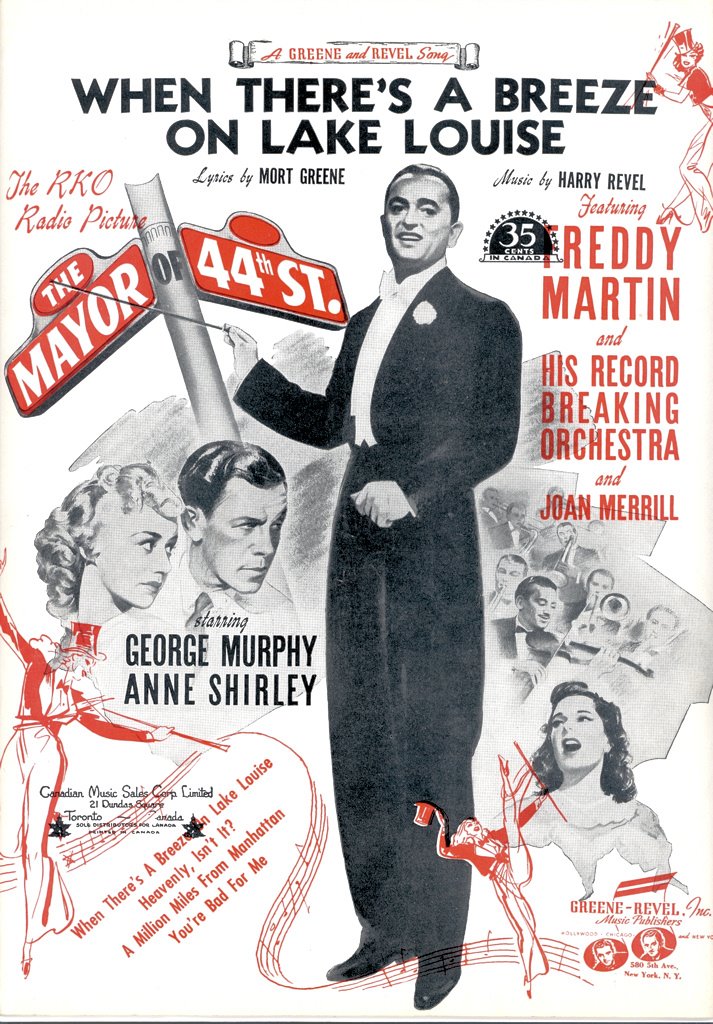
“When there’s a breeze on Lake Louise ... there on a cool Canadian June night” – from this Hollywood movie – was a hit tune for the Freddy Martin Orchestra in 1942. In Canada it was also a big hit for the Western Gentlemen led by Mart Kenney, grandfather of the present-day Harper government cabinet minister, Jason Kenney.
In the real world of rational thought (if not Canadian practical politics), the debate about Senate reform in Canada over the past 30 years has made at least one thing clear. The kind of so-called “Triple E” or elected, equal, and effective Senate that has operated in the United States and Australia since the early 20th century will not work in Canada’s more diverse federation. The big fly in the ointment here is “equal” – which means equal provincial representation, or an equal number of Senate seats for each province. (And see below for more detailed reasons why.)
Some from Western Canada – original hotbed of Canadian Triple E enthusiasm – have got this message. The Alberta journalist Lorne Gunter, eg, nowadays at least alludes to redistributing the present allocation of Senate seats “so each province has more nearly equal representation” (italics mine). Saskatchewan Premier Brad Wall has lost faith in Senate reform altogether. Like the Tommy Douglas New Democrats who once dominated his province, he is now saying that “his Saskatchewan Party will hold a referendum to see whether its members think the Senate should be abolished.”
At the same time, Alberta Premier Alison Redford is still urging (as she did last week) : “The province of Alberta and our government has been very clear that we think the Senate needs to be Triple-E … It needs to be equal. It needs to be elected and it needs to be effective.”
Similarly, Jesse Kline at the National Post who “holds a Master of Journalism degree from the University of British Columbia in Vancouver and a degree in Policy Studies from Mount Royal University in Calgary,” has recently written that back in the day when the modern Senate reform movement started in Western Canada : “It was hoped that a Triple-E Senate could provide better representation for Canadians who lived outside of Ontario, Quebec and the Atlantic provinces.” Yet a reformed Senate with equal provincial representation would give a Senate majority to “Ontario, Quebec and the Atlantic provinces” (which has six provinces to Western Canada’s four provinces). Mr. Kline still urges that : “Dismissing constitutional reform as too hard is no longer an excuse for inaction. Real Senate reform – ideally the realization of the long-sought Triple-E model – would turn an anachronism into an asset for Canada.” I would warmly embrace this argument myself, if “ ideally the realization of the long-sought Triple-E model” were left out. And, as best I can tell, this model has not in fact been long-sought by the majority of provinces.
2. Justin Trudeau and the province that is not a province like the others in Quebec

Justin Trudeau and wife Sophie Gregoire meet up after the March 31.2012 boxing match with Senator Patrick Brazeau. Photo by Gio Vanni.
One big reason the equal provincial representation part of the Triple E model won’t work in our more diverse confederation in Canada is that the French-speaking majority province of Quebec has long maintained it is “not a province like the others” (pas une province comme les autres ou une province pas comme les autres). And this was effectively (and overwhelmingly) acknowledged by the Canadian House of Commons in late November 2006, when it recognized “that the Québécois form a nation within a united Canada.”
The still so sad and unhappy extent to which we in the “Rest of Canada” do not seriously understand or acknowledge all this (despite the late November 2006 recognition by the Canadian House of Commons – and Stephen Harper’s own “PM declares that the Québécois form a nation within a united Canada”) is reflected in some crocodile-tear outrage over recent Senate reform comments by new federal Liberal leader Justin Trudeau (made in French in Quebec).
On this front, see, eg: “Trudeau defends Senate comments” ; “Tories turn the tables on Trudeau over Senate reform in raucous question period” ; “Is Trudeau showing favouritism for Quebec?” ; “More J.T. anti-West bigotry” ; and “Justin Trudeau again reveals anti-West feelings … Trudeau has revealed himself time and again to think of Quebec as a special province within Confederation, deserving of special treatment and privilege … His stance is naïve, obnoxious and divisive all at the same time.”
I wouldn’t pretend to know just how to walk around all this successfully, in the incredible Canadian manner, say, of William Lyon Mackenzie King. But I do have three further quick thoughts, which may or may not be helpful to someone, somewhere, at some point in time …
(1)Â My semi-professional interest in Senate reform in Canada flows from a book I once wrote on the subject, at a publisher’s suggestion. It appeared in1990, just as the Meech Lake Accord was coming apart. After the failure of the follow-up Charlottetown Accord a few years later, I was invited to give a talk to a Senate Clerks’ staff seminar in Ottawa. The event was also attended by some actual senators, including several from Quebec. One strong memory has stuck with me. I grew up on the anglophone northwest shore of Lake Ontario, and I may have been too impressed by some 1990s coffee-break chatter with Quebec francophone senators. They had their own strong memories of Western Canadians in Ottawa, who happily confessed contempt for the “Frenchies” east of the Ottawa River. We all have our fair shares of blame in these kinds of cross-Canada syndromes, no doubt. Yet as I read Ezra Levant on “More J.T. anti-West bigotry” or Lorne Gunter on “Justin Trudeau again reveals anti-West feelings,” in my collection of 32 Senate reform articles in Canada today, I remember my coffee-break tutorials with Quebec senators in the 1990s . Let he (and/or she too of course) who is without guilt, etc, etc.
(2) I can also recall contemptuous things Justin Trudeau’s father said about my English-speaking Canadian hometown, years ago. I believe Justin Trudeau himself has said some foolish things on Senate reform and much else, as he struggles to find his mature political feet between now and the next federal election in 2015. Yet his recent controversial Quebec comments on Senate reform are at least trying to show the Québécois nation within a united Canada (and French Canadians outside Quebec too) that they ought to see the Senate of Canada as something which can or at least could work in their Canadien interest. And in my own moments of sober second thought, this strikes me as quite good and forward-looking, regardless of anything else.
(3) No reform of the unreformed Senate of Canada that does not finally have Quebec on board can finally work and endure. According to section 42 of the Constitution Act, 1982, an amendment to the Constitution of Canada with regard to “the powers of the Senate and the method of selecting Senators” and “the number of members by which a province is entitled to be represented in the Senate and the residence qualifications of Senators,” could technically be made without the agreement of Quebec. (Provided that at least Ontario was on board. You need “resolutions of the legislative assemblies of at least two-thirds of the provinces that have, in the aggregate, according to the then latest general census, at least fifty per cent of the population of all the provinces.” At the moment, Ontario has just under 39% of the total Canadian population and Quebec has 23%. So … just do the math.) Yet any major reform of the Senate of Canada passed without Quebec’s endorsement could only significantly weaken the 1867 confederation’s prospects for long-term survival. That of course does not mean Quebec can dictate its own terms. But it doesn’t mean that Quebec can just be ignored either (as some thoughts about the Canadian future since 2006 do sometimes seem to assume).
3. Has Ontario’s congenital obtuseness on Senate reform in Canada really ended?
Another reason the equal provincial representation part of the Triple E model won’t work in Canada is that, to a greater degree than either the United States or Australia, the Canadian federation is unusually strongly polarized between more populous and less populous provinces. California, eg, the current most populous state of the union (with a population greater than all of Canada in fact), has only about 12% of the total population of the United States. As already just noted, on the other hand, Ontario currently has just under 39% of the total population of Canada (and Quebec has 23%).
Put another way, in the eyes of many Ontario residents a provincially equal Senate would mean that every one person in Prince Edward Island is worth 93 people in Ontario – which, from the standpoint of a cross-Canada democracy of equal citizens does seem outrageous. You can of course say that this is what a regionally representative Senate is supposed to do in a geographically vast federation. But, eg, the comparable number for the United States is at least not quite as egregious. There a Senate with two senators for each state only means that every one person in Wyoming is worth 66 people in California.
With thoughts of this sort no doubt in mind, former Ontario Premier Dalton McGuinty had come to the same conclusion that Brad Wall now seems to be contemplating in Saskatchewan. The best thing to do with the unreformed Senate of Canada is to abolish it altogether. Ontario’s new Premier Kathleen Wynne, however, has just gone on record with: “I actually believe that there is a role for a chamber of sober second thought, but there is always room for reform …The discussion of what those reforms should be is an important one, and at the provincial level I would be interested in engaging with my colleagues across the country … It’s not something that I have taken a firm or detailed stand on, but it’s certainly something that I’m willing to engage on.”
Two other recent opinion pieces by other eminent Ontarians have nonetheless suggested that a certain traditional congenital obtuseness on Senate reform in Canada’s most populous province remains more or less intact.
The first is “Gregory Sorbara’s formula for an independent, non-partisan Senate … Prime Minister Harper could leave a lasting legacy as the prime minister who gave up the luxury of offering personal privilege to the few in order to more democratically serve the interest of the many” – an opinion piece that appeared in the May 22, 2013 issue of the Toronto Star. Gregory Sorbara is a former Ontario Liberal cabinet minister and influential organizational impresario. The crux of his proposal suggests that PM Harper should “voluntarily divest himself of the power to appoint new members of the Senate. That power could be transferred to a 20-member Senate Appointments Committee (SAC) made up of respected members of the Order of Canada. It would be the responsibility of the Governor General, using a lens of diversity regarding the Order of Canada cohort, to populate the members of such a committee from time to time … New senators would be appointed for a term of six years and be eligible for a one-time renewal for a further six years. The SAC would abide by the currently prescribed allocation of seats among the regions of Canada.”
I have vast respect for Mr. Sorbara and his contribution to Ontario public life. But this kind of Senate reform proposal strikes me as essentially anti-democratic. It just perpetuates the elitist, quasi-aristocratic style of the original 1867 Senate of Canada, which was far too inspired by the British House of Lords. I think there is a growing consensus among the people of Canada today that if the Senate is not going to be democratically elected, it ought to be abolished.
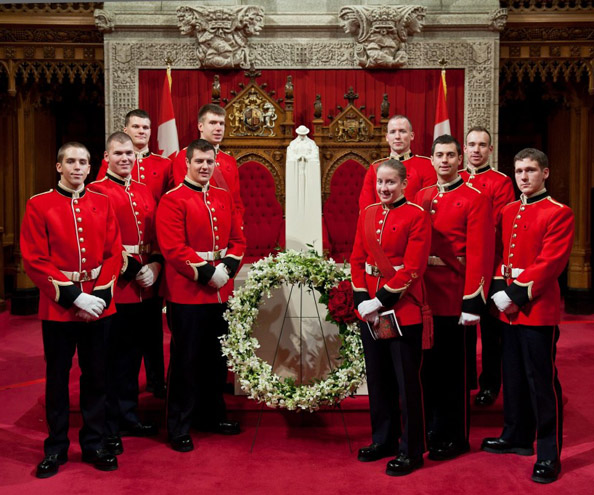
Royal Military College cadets in the Senate Chamber, commemorating the official launch of Veteran’s week, November 4, 2011. From left to right: OCdt Abel, OCdt Lane, OCdt LeBoeuf, OCdt Appolloni, OCdt Noris, OCdt Chandler, OCdt Trainor, OCdt Plante, OCdt Brosseau, NCdt Frank.
The second Ontario opinion piece is Matthew Mendelsohn’s “Abolish the Senate? Forget it: Change the Senate? Maybe” – in the May 24 issue of the Globe and Mail. Mr. Mendelsohn is “the director of the Mowat Centre at the University of Toronto and a former Ontario deputy minister of Intergovernmental Affairs. He recently released a paper, ‘A Viable Path to Senate Reform?’” (And his May 24 opinion piece is based on this paper.) The crux of his proposal is that an increasingly elected Senate of the sort which has figured in Mr. Harper’s reform proposals, without a reallocation of the current Senate seats among provinces, and with “no mechanism to break deadlocks between the House and the Senate is truly a crisis-in-waiting.” But the crisis would be defused if the elected Senate had only limited real power. And so: “The federal government should consult with provinces and canvass whether there could be support for a constitutional amendment that would remove many of the Senate’s powers, replacing them with a suspensive veto only. This would allow the Senate to delay but not block legislation.”
Elements of a similar “suspensive veto” figured in the reformed Senate of Canada proposed by the 1992 Charlottetown Accord – which also included a mechanism to break deadlocks between the House and the Senate (largely in favour of the House). Personally, I’d agree with those who urge that a Senate with only a “suspensive veto … to delay but not block legislation” is probably not worth the expense. In principle at least, it would make more sense to just abolish the thing.
4. Mike Duffy’s alleged home on the Island and Senate reform in Atlantic Canada
 The original 1867 Senate of Canada, it might be said, had two major purposes. The first was to serve as a kind of quasi-aristocratic chamber of “sober second thought” : a check, as it were, on the more hasty democratic impulses of the popularly elected Canadian House of Commons – more or less after the fashion of the House of Lords in the old Mother Country. The second was “regional representation” beyond mere population numbers, in a geographically vast federation – more or less on the model of the adjacent United States Senate. (And note that US senators were not popularly elected until a constitutional amendment in 1913. Before that they were indirectly elected by state legislatures.)
The original 1867 Senate of Canada, it might be said, had two major purposes. The first was to serve as a kind of quasi-aristocratic chamber of “sober second thought” : a check, as it were, on the more hasty democratic impulses of the popularly elected Canadian House of Commons – more or less after the fashion of the House of Lords in the old Mother Country. The second was “regional representation” beyond mere population numbers, in a geographically vast federation – more or less on the model of the adjacent United States Senate. (And note that US senators were not popularly elected until a constitutional amendment in 1913. Before that they were indirectly elected by state legislatures.)
The original Senate regional representation scheme in Canada was, as it were, by region rather than province, strictly speaking. As finally adjusted after the creation of the provinces of Alberta and Saskatchewan in 1905, Canada was divided into four regions – each of which had 24 senators : Atlantic Canada, Quebec, Ontario, and Western Canada. Back in the earlier 20th century Ontario and Quebec each had larger populations than either Western or especially Atlantic Canada. (In 1911, eg, Ontario had some 2.6 million people, Quebec 2.0 million, the four provinces of Western Canada 1.7 million, and the three provinces of the day in Atlantic Canada a little more than 0.9 million.) Yet each region had equal representation in the Senate.
Especially with the admission of Newfoundland to the confederation (at last) in 1949, this arrangement benefited Atlantic Canada more than any other region. In 1867 Atlantic Canada included only Nova Scotia and New Brunswick – each of which had 12 Senate seats. When Prince Edward Island joined the confederation in 1873, it was assigned four Senate seats and Nova Scotia and New Brunswick were each reduced to 10 seats, preserving the 24 seats for the Atlantic Canada region at large. But when Newfoundland finally joined in 1949, the other three Atlantic provinces kept the Senate seats they already had, and Newfoundland (and Labrador) was given an additional six seats.
The resulting arrangement for the country at large today is:
ATLANTIC CANADA –Â 30 seats (NB and NS 10 each, Nfld and Lab 6 seats, PEI 4 seats)
QUEBEC –Â 24 seats
ONTARIO –Â 24 seats
WESTERN CANADA – 24 seats (Alta, BC, Man, and Sask 6 seats each)
TERRITORIES — 3 seats (Nunavut, NWT, and Yukon 1 seat each)
TOTAL – 105 seats.
(The parallel population numbers using Statistics Canada estimates for the first quarter of 2013, btw, are : Ontario 13.6 million people, Western Canada 10.9 million, Quebec 8.1 million, Atlantic Canada 2.4 million, Territories 0.114 million.)
Because it benefits from the Senate’s current regional representation arrangements more than any other part of the country, Atlantic Canada is often seen as the region most resistant to significant Senate reform. Two items from my collection of 32 Senate reform articles in Canada today suggest that conclusions of this sort can be at least somewhat misleading.

Stephen Harper and rare elected appointee Senator Bert Brown from Alberta acknowledge a standing ovation at the start of a Conservative caucus meeting on Parliament Hill in Ottawa, October 17, 2007.
(1) “EDITORIAL: Senate reform sorely needed” from the May 23 Hants Journal (in the Halifax exurbs, more or less) was mostly concerned about how “Mike Duffy should be ashamed.” over his role in the “Senate expense scandal,” which is “enough to make anyone cringe … Political analysts, commentators and journalists are having a field day. Social media is fired up. It’s time to capitalize on this new wave of public discontent. Senate reform is needed … Currently, new Senate members are appointed by whoever is in power. This time, it’s the Conservatives, and they’ve stacked the Senate with party faithful. Duffy falls into that category. He was appointed in 2008 by Prime Minister Stephen Harper … This scandal clearly demonstrates it’s time for a change. In fact, it’s long overdue.” Just what the change might involve was not discussed. But Nova Scotia’s current NDP premier, Darrell Dexter, is on record as a supporter of abolition.
(2) “Alward’s Senate reform plans on hold,” from the CBC News/New Brunswick website on May 30, shows that at least some Atlantic Canadian Conservatives have been interested in Stephen Harper’s Senate reform plots. David Alward’s Conservative government had proposed that“New Brunswickers vote on which names should be submitted to Ottawa for appointment to the Senate by the prime minister” – in the spirit of the longstanding Harper Senate reform proposals. But now the “Alward government has put on hold its plan for Senate elections as it waits to see a ruling from the Supreme Court of Canada on reforming the institution …The Progressive Conservatives had tabled a reform bill last year, but it died with that last session … The federal government has since asked the Supreme Court of Canada to rule on whether changing the Senate requires changing the constitution … Deputy Premier Paul Robichaud said there is no point passing a bill before Canada’s top court rules on the question.”
5. “That won’t stop the NDP from consistently calling for abolition, but the Supreme Court’s opinion is what everyone awaits. So we wait.”
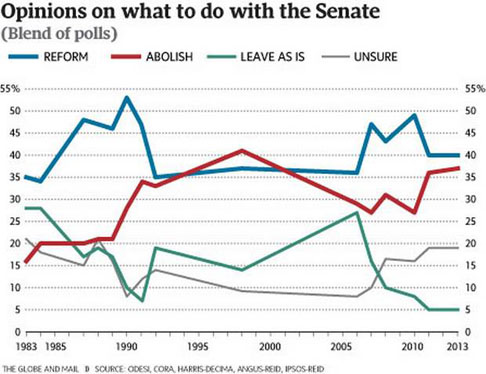 The current Senate expense scandal may be increasing popular enthusiasm for just abolishing the Senate of Canada altogether. On May 30, 2013 Éric Grenier, who “writes about politics and polls at ThreeHundredEight.com,” reported : “Support for abolishing the Senate is creeping upwards, and the recent scandals seem unlikely to reverse the trend.”
The current Senate expense scandal may be increasing popular enthusiasm for just abolishing the Senate of Canada altogether. On May 30, 2013 Éric Grenier, who “writes about politics and polls at ThreeHundredEight.com,” reported : “Support for abolishing the Senate is creeping upwards, and the recent scandals seem unlikely to reverse the trend.”
Abolishing the unreformed Senate of Canada may seem like the simplest reform option, in theory. And I agree myself with a proposition increasingly advanced by frustrated Senate reformers : If the institution cannot be reformed, for whatever complicated low-ground political reasons, then it should just be abolished. The last thing that ought to be done is just leave the unreformed Senate as it is now. (As attractive as that option often still seems to be to many unreformed senators – apparently including some whom Prime Minister Harper has recently appointed, on the understanding that they would support his reform proposals.)
At the same time, it may be that abolishing the Senate will prove almost impossible in practice. Some critical provinces may feel they have too much to lose if the institution disappears.
According to one part of the amending formula in the Constitution Act, 1982 (sections 38, 42) abolishing the Senate will also require the approval of a majority of members of the Senate itself. And anyone who has paid close attention to the visceral realities cast into bold relief by the expense scandal of the past few weeks may be pardoned for suspecting that it may not be at all easy – even in Stephen Harper’s new Conservative majority Senate of Canada – to put together a majority of senators willing to vote for their own abolition.
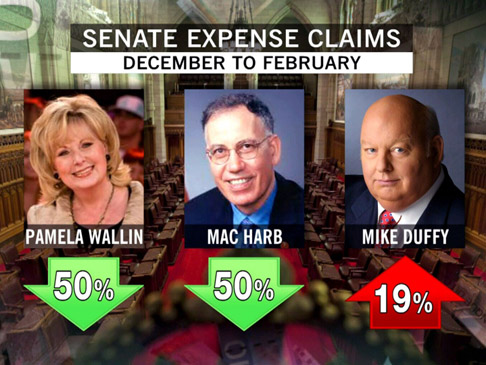 According to another part of the Constitution Act, 1982: “An amendment to the Constitution of Canada … may be made without a resolution of the Senate … if, within one hundred and eighty days after the adoption by the House of Commons of a resolution … the Senate has not adopted such a resolution and if, at any time after the expiration of that period, the House of Commons again adopts the resolution” (section 47). Yet there may be some further complications here (which the Supreme Court will hopefully sort out). Abolishing the Senate of Canada may only be possible, or at least most likely, under a New Democratic Party government in Ottawa. The NDP has long supported abolition. And an NDP federal government (something that has never happened yet, but is arguably closer than ever before) may best be able to mobilize the kind of support – federally and provincially – that abolition would require.
According to another part of the Constitution Act, 1982: “An amendment to the Constitution of Canada … may be made without a resolution of the Senate … if, within one hundred and eighty days after the adoption by the House of Commons of a resolution … the Senate has not adopted such a resolution and if, at any time after the expiration of that period, the House of Commons again adopts the resolution” (section 47). Yet there may be some further complications here (which the Supreme Court will hopefully sort out). Abolishing the Senate of Canada may only be possible, or at least most likely, under a New Democratic Party government in Ottawa. The NDP has long supported abolition. And an NDP federal government (something that has never happened yet, but is arguably closer than ever before) may best be able to mobilize the kind of support – federally and provincially – that abolition would require.
Meanwhile, as Nick Taylor-Vaisey explained on the Maclean’s website, on May 23, 2013 : “In the immediate future, as far as Senate abolition is concerned, nothing happens. That won’t stop the NDP from consistently calling for abolition, but the Supreme Court’s opinion is what everyone awaits. So we wait.” (And as best as I can make out, the Supreme Court may deliver its Senate reform wisdom by the end of this year, or even sooner. Or it may take a while longer …)
6. My personal Senate reform fantasy – one last time (but how much longer can Canada last, really, if it can’t even reform a Senate that desperately needs reform?)

Alberta has held “Senate Nominee Elections” of the sort the Harper government’s reform plans have contemplated spreading to all provinces, in 1989, 1998, 2004, and 2012. Five “senators in waiting” elected in this way have now been appointed to the Senate – one by Brian Mulroney and four by Stephen Harper. Doug Black is one of them. Bert Brown, Mr. Harper’s first appointment of this sort, is now retired. Three of Alberta’s current six senators have been elected in Senate Nominee Elections.
My 1990 book on Senate reform in Canada was the kind of project in which you learn more after the book is published than you did while you were writing the thing. And for some time now, my views have been somewhat different from what they were when I wrote the book.
Though I have yet to meet someone who really cares, I have also supported Stephen Harper’s so-called “step by step” Senate reform proposals, as at least a useful step forward. They have two main elements – setting senatorial term limits at nine years, and providing for provincial Senate “elections,” to advise the federal prime minister on who to appoint to the Senate for the province in question. The beauty of these proposals was that they were supposed to be possible without a constitutional amendment requiring provincial approval. But the current Supreme Court reference has now tarnished this beauty. (I am among those who believe that if Mr. Harper were altogether serious about Senate reform, he would have finally passed his term limit and Senate election legislation after he won a majority government in the 2011 election – and then let whatever provinces were against what he had done ask the Supreme Court for further advice. That he did not do this may mean he has morphed into a shrewd but over-cautious traditional Canadian politician. Or it may mean he is just not the person who will finally lead Canada into the promised land of an unreformed Senate that is actually reformed at last.)
As far as I’m concerned, the Harper government’s “step by step” Senate reform proposals have been criticized on two main grounds. The first is that they have sidestepped the really crucial question of just how the seats in a reformed Senate are finally going to be allocated by province. The second is that they do not suggest a mechanism for dealing with potential conflicts between the elected Canadian House of Commons and a new elected Canadian Senate.
To confront the second critique of the Harper proposals first, Canada’s fellow parliamentary democracy of Australia already has a procedure for dealing with intermittent conflict between its “upper”Senate and its”lower” House of Representatives. And Canada may want to take some useful instruction from that source. Meanwhile, some years ago I settled on a scheme of provincial/territorial representation in the Senate of Canada that meets the local objections to equal provincial representation, just for my own peace of mind. Of course no one has paid much attention to this particular plot. And in my advancing age I am much less persuaded about the power of rational thought than I used to be . In any case here is what I still vainly think the ultimate scheme of provincial representation should be myself :
NB – 3 seats
NFLD & LAB – 3 seats
NS – 3 seats
PEI – 3 seats
ATLANTIC CANADA – 12 seats
QUEBEC – 12 seats
ONTARIO – 6 seats
CENTRAL CANADA – 18 seats
MANITOBA – 3 seats
SASKATCHEWAN – 3 seats
ALBERTA – 6 seats
BRITISH COLUMBIA – 6 seats
WESTERN CANADA – 18 seats
TERRITORIES – 6 seats
TOTAL – 54 seats
Of course I do not know what will ultimately happen in the real world of politics. And it is not very likely that my ultimate “Québécois-nation-within-a-united-Canada/more-nearly-provincially-equal” scheme of provincial representation in a reformed Senate of Canada will finally be realized – any more than a Triple E Senate, or a Senate chosen by the Order of Canada, etc, etc. The current Senate expense scandal also raises in my as no doubt many other minds the prospect that doing anything sensible with the Senate of Canada is just a vain political fantasy. Canada is a country whose fundamental problems are never resolved, and all that.
As I get older, however, I do wonder more and more whether the old kind of Canada whose fundamental problems are never resolved will actually be able to make it through an increasingly challenging 21st century. I also unhappily realize that I am not going to live all that much longer myself, and why should I bother at this stage of my life with what may actually be just vain political fantasies? At the same time, I think Canada has done very well by me (and many other people), and I continue to hope it has a very bright future. We ought to be able to solve our now very long-lived Senate reform problem. And I certainly hope we will – before I and others like me go off to some kind of new spiritual existence on the planet Mars, or wherever else it is that we increasingly older people finally go.
Meanwhile, as a still confirmed Canadian Senate reformer I find I can actually take at least some sustenance from my 32 recent press articles on Senate reform in Canada. To take just a few final examples :
* As a longtime Ontario resident, I am pleased that Ontario now has a premier who is seriously open to Senate reform, and has advanced what probably is the wisest strategy for this moment in time: “there is always room for reform …The discussion of what those reforms should be is an important one, and at the provincial level I would be interested in engaging with my colleagues across the country … It’s not something that I have taken a firm or detailed stand on, but it’s certainly something that I’m willing to engage on.” Cheers for Ms Wynne.

According to Maclean’s magazine : “The Senate is Canada’s institution for sober second thought, but some senators have been distracted by other matters lately–namely Sen. Rod Zimmer, 69, and his 23-year-old wife, Maygan Sensenberger ... Sensenberger and Sen. Zimmer became international news in August 2012–their one-year wedding anniversary–when Sensenberger caused a disturbance on a flight from Ottawa to Saskatoon and received a 12-month suspended sentence with one-year probation.” Would Senate reform change this kind of thing? Probably not, but ... Photograph by Blair Gable.
* I disagree with Jesse Kline about “the long-sought Triple-E model.” But other things he has said recently still impress me, and bolster my hope for the future; eg: “a nation that successfully patriated our Constitution from the British, signed a historic free trade agreement with our neighbours and balanced the budget after years of overspending, should not be afraid of big challenges … Dismissing constitutional reform as too hard is no longer an excuse for inaction. Real Senate reform … would turn an anachronism into an asset for Canada.”
* I don’t quite agree with everything in the Saskatoon Star Phoenix’s May 22, 2013 Senate reform editorial either. But I like other parts so much that I want to conclude by quoting from this piece again: “during his time as prime minister Mr. Harper has also demonstrated why Canada needs an effective and democratic check on executive power … In a report issued this month by the Washington-based Transatlantic Academy, entitled Democracy in Trouble, political scientists David Cameron and Robert Vipond compare how two of the world’s oldest and most successful democracies –Â Canada and the United States –Â have stumbled into difficulty. In the case of America it’s because of partisan-orchestrated stagnation, while in Canada it is the effect on the electorate of the ‘friendly dictatorship’ with all the power emanating from the PMO …But Canadians are constantly told they don’t have the stomach for the Constitutional reform necessary to right the ship. In fact, it’s the politicians who don’t have the stomach for it.”
As alluded to at the start, we the ordinary people of Canada have to assume some responsibility for our country’s present plight as well. Over the past few weeks of Senate reform debate in the true north etc, I have been reminded of what Pogo used to say in a now forgotten era: “We have met the enemy, and he is us.” My commitment here is to at least try to think hard about what this means, and then report back to this space about what I have thought, when the Supreme Court of Canada finally tells us what it thinks about Mr. Harper’s questions on Senate reform. And if this doesn’t work, I will probably check myself in for rehab, someplace on Vancouver Island.
Randall White, a former Ontario public servant who now works as an independent public policy consultant, is the author of a number of books on Canadian history and politics, including Voice of Region : The Long Journey to Senate Reform in Canada.
THE 32 ARTICLES:
1. Move to elected senate, says former Liberal leader
2. Senate of Canada: Reform or Abolish?
3. Alward’s Senate reform plans on hold
4. Canadians want to reform or abolish Senate: polls … Éric Grenier
5. PoV: Reform, not abolition, the answer for Senate
6. Stephen Harper’s team keeping Senate minefield behind a smokescreen – Hébert
7. Ontario’s Wynne wants to see Senate reformed
8. Harper goes on attack as Duffy questions mount
9. Senate committee votes to send Mike Duffy matter to the RCMP
10. Jesse Kline: Canada needs Triple-E Senate reform
11. Don’t abolish Senate, reform it for provinces
12. EZRA LEVANT : More J.T. anti-West bigotry
13. LORNE GUNTER : Justin Trudeau again reveals anti-West feelings
14. Stephen Harper turns aside demands for public hearings on Duffy affair
15. Harper divulges little over Mike Duffy affair during Question Period
16. Pessimism about Canada’s future puts bite in Senate scandal: Gwyn
17. Is Trudeau showing favouritism for Quebec?
18. Trudeau defends Senate comments
19. Tories turn the tables on Trudeau over Senate reform in raucous question period
20. House of Lords offers a Plan B for Senate reform
21. National News: Justin Trudeau’s Liberals Oppose Senate Reform, Champion the Status Quo
22.The Senate Scandal Will Be Harper’s Downfall
23. Alberta to continue pushing for elected Senate, Redford says
24. The Soapbox: Senate scandal showcases need for reforms
25. EDITORIAL: Senate reform sorely needed
26. Abolish the Senate? Forget it: Change the Senate? Maybe
27. A Viable Path to Senate Reform
28. Major Upper Chamber reform needed, say Manitoba Senators
29. How to abolish the Senate of Canada
30. Failed reform carries a cost
31. Gregory Sorbara’s formula for an independent, non-partisan Senate
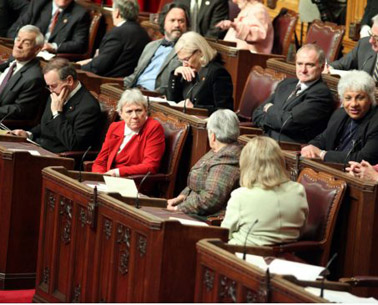
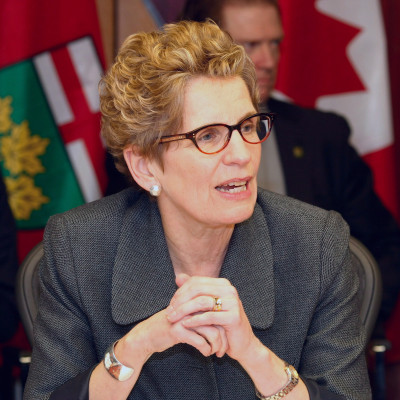


this is the last straw! Canada Senate has cost the country billions of dollars over the years! All are politcal appointments for those loyal to the party!
End this once and for all ~ remove the senate – buncha old dogs collecting megabucks, charging all sort of various fraudulent claims!
End it
If constitution has to be changed, then for goodness sakes lets get the damn old ancient document into this century!
Harper will have to deal with this problem, its not going to go away! If he wants any chance for re-election this issue will have to be resolved, constitution changed and senate abolished!
Lord only know what that kook trudeau will ever do if he is ever elected and in power, lord knows his father really screwed things up!
This was a thorough and thought provoking post. However it didn’t address my biggest question about senate reform – the reasons people say we need senate reform in the first place! The dust-up over the spending scandal is a pitiful reason to abolish a whole house of government. Is it the unrepresentative allocation of seats? That was the point in 1867, to give the smaller provinces a voice. Is it the unelected appointments? Again that was the point in 1867, a balance to the “rule of the mob” nineteenth century thinkers feared as the common man gained universal sufferage (and, egads, women too!) which would drive the elected House down radical roads. It was to be a group of policy-makers not subject to the whims of the day. Are the reasons purely political? A need for control by the PMO? All the more reason to maintain the senate as a check on absolute power.
I can see the need to tweak it, mostly to tighten up spending oversights and slightly re-distribute the seating arrangement due to growth in the west over 100 years, but abolish? Radically re-align? Elect? I just don’t see the need. Maybe you need a post on that topic…